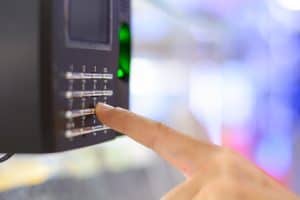
Having CCTV in and outside of buildings is now standard practice, and access control systems are becoming more common too. Because they’re easy to install and provide vital security, they are a must-have in this day and age.
This blog will discuss access control systems in great detail and explore the different systems available.
What is Access Control?
Although there are different mediums that access control operates across, the main function remains the same. It’s a security system that regulates which individuals can gain entry to a physical area such as a room or building, or a virtual area such as locked computer files.
Types of Access Control systems

The 5 main types of access control systems in commercial use are:
- Mandatory Access Control (MAC)
This is set up so that only the administrator has access to the controls. The MAC system is mostly used in organisations which prioritise confidentiality, as there is no chance of anyone other than the administrator modifying or changing the access controls.
2. Discretionary Access Control (DAC)
This system allows the business owner to be responsible for specifying which personnel have permission to be in a physical location or gain access to certain digital files. This places the full accountability on the owner meaning it’s less restrictive than the other programmes.
3. Role-Based Access Control (RBAC)
RBAC is a popular system as it is fairly straightforward in that it only allows personnel to view the data that is relevant to their role. Once a user’s information has been added to the system then it will automatically implement the necessary security principles.
4. Rule-Based Access Control
This is a system that is often used in combination with role-based access control as together they are effective at ensuring comprehensive security. It works by setting rules based on certain conditions, such as location or time.
5. Attribute-Based Access Control (ABAC)
This model allows for attributes to be organised as a structured language which can, under certain situations, allow individuals to gain access to rooms or data based on the combination of their acquired attributes.
The Evolution of Access Control
It’s clear that there are many forms of access control. We’re at a stage now where it’s commonplace to see access control in many different environments. From hospitals to warehouses and everywhere in between, these systems are everywhere. But how did it all start?
Early access control systems were designed to allow a user to enter a PIN code that would grant them entry to certain areas. Although PIN codes are still used regularly in modern life, in the world of access control they’re already extremely outdated.
Entering a PIN takes time, and there’s also the risk of individuals forgetting their codes. People might accidentally misclick and end up being locked out for a period of time. PIN codes were quickly replaced by faster, more fail-safe methods.
Access control systems quickly evolved on to what are generally known as ‘pass cards’, which take the forms of:

Magnetic Stripe
They keep the identity number along a designated track.
Barcodes
They display identity numbers in the form of a series of bars with differing widths. This is one of the least secure pass card systems, as barcodes can be copied or reproduced.
Proximity Cards
They need to be held within centimetres of the reader for the electronic chip. Then they are scanned and accepted by a radio frequency scanner.
Smart Cards
These are related to proximity cards and operate in a similar manner, utilising radio technology to identify a variety of data within the chip. Brand-leading access control suppliers Paxton have recently released a new product, Paxton 10. Paxton 10 is the most powerful security system Paxton has manufactured. It combines door access control with a range of surveillance cameras. The smart pass cards are already highly secure, and when paired with video management they provide an all-encompassing security service with a long list of features. With Paxton 10 installation available at an affordable price, it’s an appealing offer to any company or business owner looking for an effective and reliable security system.
Biometric readers
They require users to input their biometric data into a system and then present themselves to the biometric scanner every time they wish to pass through. This is perhaps the securest method of security. It’s very difficult to copy or reproduce someone else’s physical biometric data, but it’s also an extremely expensive system.
Apart from Biometric readers, each of these pass cards requires personnel to carry a physical card around with them. With the most recent technological advancements, methods have been developed that make the need to remember a PIN number or even carry physical cards around completely unnecessary.
Conclusion
In a relatively short amount of time, access control systems have gone from requiring users to remember a PIN number to being able to scan and read a user’s fingerprints. The speed at which technology is advancing is allowing for huge developments to be made in a number of industries, and security is definitely one of them.
Click here for more information on the access control systems we supply. If you have any further questions, feel free to give us a call on 0800 0213 264 to speak to a member of our experienced team.